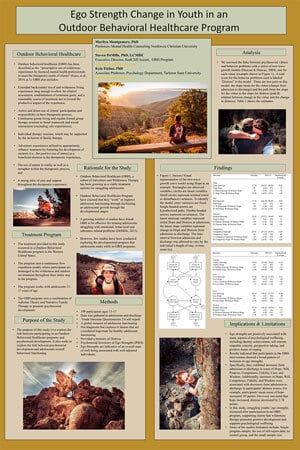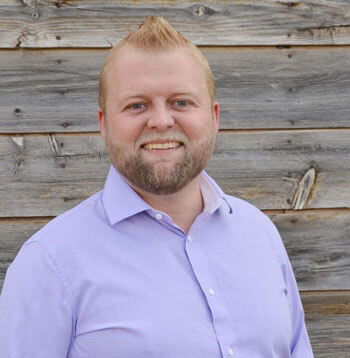30 Years of Wilderness Therapy Research
Written by: Steven DeMille, Ph.D. LCMHC
One of the most commonly asked questions that loved ones ask is, does wilderness therapy work? Over more than three decades, RedCliff Ascent has been conducting scholarly research to answer that question. Yes! It does work.
Any program can claim to be effective. Few programs have taken the necessary steps to create a genuinely evidence-based program. The page you are reading provides a snapshot or overview of the various wilderness therapy treatment studies conducted by RedCliff Ascent and others.
RedCliff Ascent has a responsibility to families to demonstrate that our program can help their loved ones. These studies provide the foundation for the program.
Evidence-based practices create a strong foundation for effective wilderness therapy. Research guides and shapes the services provided. The practices are chosen because there is research to indicate they result in the best outcomes, ensuring the highest quality treatment possible.

Using research helps RedCliff Ascent make better treatment decisions in real-time.
Using research helps RedCliff Ascent make better treatment decisions in real-time. Having a program guided by evidence-based practices means that the program is continually evolving and adapting. In addition to our testimonials, experience, and success stories, RedCliff Ascent has a body of research supporting the program's efficacy. Families may review our research on safety, health, and psycho-social outcomes. The information provided by this research can help families find the confidence that RedCliff Ascent is the right place for their loved ones.
In Order to Hold Wilderness Therapy to a Higher Level, We Are Redefining How It Is Handled
When developing and maintaining our wilderness program, we use a hierarchy of different types of research. Starting from the top, we have matched control group outcome studies, moving down we have, longitudinal time-series studies, case studies, ending with professional articles, ideas, expert opinions, editorials, and anecdotes. As researchers, we recognize the importance of all research in healing those we set out to help. Each tier plays its own role in establishing the effectiveness of our program. We use all outlets available to us, culminating in a tailored program specifically designed to help your teen. Research can often seem impersonal, but as therapists, first and foremost, we create the right treatment plan for your family; we practice a higher quality of excellence.
RedCliff Ascent set out to hold wilderness therapy to a higher level by revolutionizing the way it had been handled in the past. Through research and honing, RedCliff Ascent has set the standard for such therapy. As a founding member of the Outdoor Behavioral Healthcare Council (OBHC), an organization designed to set forth guidelines for best practices, research, and accreditation, RedCliff Ascent has established the standards for all quality wilderness therapy programs. We don’t just participate in excellence, we created it!
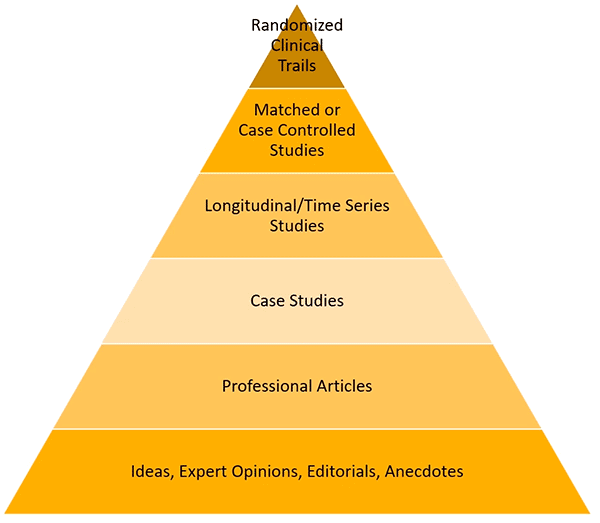
Our main goal is and always will be to provide the safest, and most effective wilderness therapy program out there.
Our main goal is and always will be to provide the safest, and most effective wilderness therapy program out there. Through each aspect of our program, we seek to heal our participants. With our proven methods of treatment, we disrupt unhealthy behavior patterns. Through assessment and observation, we learn just what it is your teen needs to move forward in a healthy way. We practice complete transparency with your family. Therapists will meet with families each week, giving you a chance to see your teen’s progress. You will also have access to your teen’s therapy portal that shows all of the assignments and exercises that are on your teen’s regimen. We even post weekly pictures of your teen in action! We want you to be active and engaged in your teen’s recovery. Participants will exchange letters with their families, providing a constructive outlet to communicate with each other. Each member of the family has a chance to give and receive feedback, strengthening those familial relationships.
When your teen heals, the family dynamic rights itself as well. We are so confident in our approach, we welcome questions and concerns and listen to your family’s needs. Our program works; time and again RedCliff Ascent has proven its effectiveness in teen recovery.
The Gold Standard of Adolescent Research
Before treatment outcomes could be measured, a metric had to be developed. That metric became known as the Youth Outcome Questionnaire (Y-OQ ).
The Y-OQ is a global measure of adolescent functioning, meaning that it looks at more than one type of functioning.
The Y-OQ looks at six different areas of adolescent functioning, and then it generates an overall score.
Before being put to use in research, the Y-OQ was normed and validated. It was scientifically demonstrated to be a useful instrument to assess a teen's overall functioning.
Higher scores signify higher levels of distress and dysfunction. Lower scores signify healthier adolescent functioning.
Teens who score within a specific range are considered healthy. Teens whose scores show elevated levels of critical distress may need outpatient treatment. For teens with high scores, inpatient treatment or hospitalizations may be appropriate.
Before treatment outcomes could be measured, a metric had to be developed. That metric became known as the Youth Outcome Questionnaire (Y-OQ ). Before being put to use in research, the Y-OQ was normed and validated.
Consistent Treatment Outcomes
The first study into the efficacy of wilderness therapy treatment was conducted in 1999. As would be expected, the teens entered treatment at high levels of distress. The average overall Y-OQ score was 98. A score at this level is comparable to teens who are in long-term inpatient treatment facilities.
Researchers monitored the teens during and after treatment. The result of the first study was remarkable.
The teens' average score dropped from 98 to close to 46. A Y-OQ score of 46 is within the healthy range of functioning. The first study was a profound validation of the positive impact of wilderness therapy.
The Y-OQ would be an important tool used in multiple future studies. Various researchers replicated the results of the original study.
In each case, teens entered treatment with high levels of distress and dysfunction. Through treatment, teens were able to reach healthy levels of functioning. The teens maintained these healthy levels of functioning when researchers followed up with the teens up to one-year post-treatment.
Successful treatment outcomes were replicated in more than a half-dozen long-term studies spanning nearly two decades.
Research At RedCliff Ascent an Overview Video
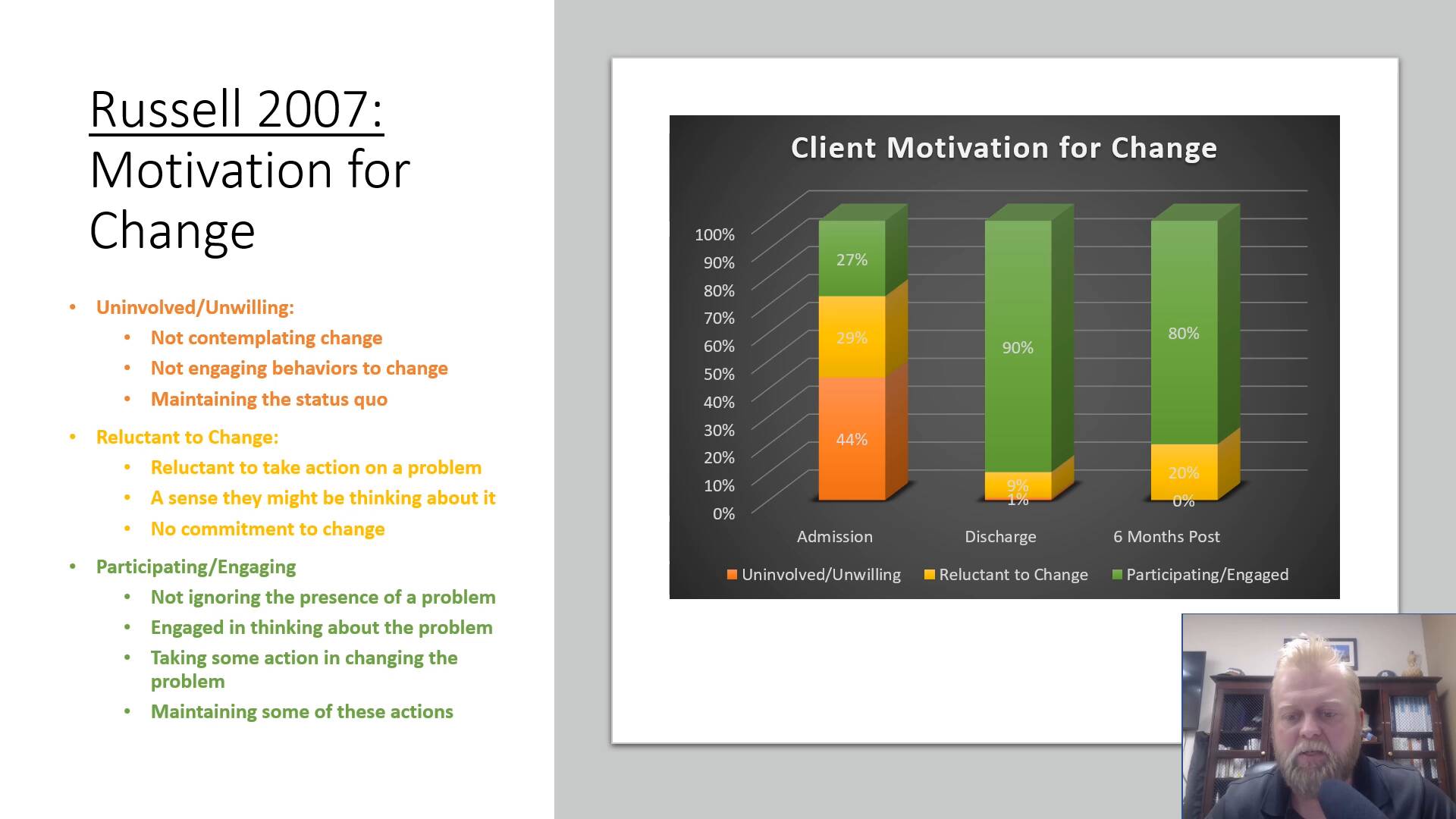
Factors that Predict Treatment Outcomes
Models of Treatment Study (Russell 2003)
Some forms of wilderness therapy treatment are more effective than others. Examining different forms of treatment at different locations helped establish which types of wilderness therapy produced the best outcomes.
At some programs, teens spent most of their time outdoors exploring the backcountry. They worked together in small groups. This became known as the Continuous Flow Expedition model.
In other programs, teens remained at a primary location such as a campsite or a cabin. Teens periodically took part in expeditions or adventures. This became known as the Basecamp model.
A comparative analysis showed that the Continuous Flow Expedition model resulted in better outcomes than the other models.


Length of Stay Study (Russell, 2004)
A subsequent study compared the outcomes of short and long-term wilderness therapy programs.
At that time, there were many 30-day wilderness therapy programs as well as longer-term programs. Longer-term treatment programs demonstrated a clear benefit to teens and their families.
Over time, there was a gradual shift away from 30-day programs. Longer-term programs became the norm.
Moreover, this study corroborated that more time in the wilderness, as in the Continuous Flow Expedition model, resulted in better treatment outcomes.
The longer the program the better the results. Spending more time in the wilderness on expedition, has the potential for greater impact.
References:
Adventure Education and Therapy
Two Year Follow-up Study (Russell, 2005)
It's natural for parents to wonder if the changes they see in their teenager after treatment will last at home. A study from 2005 examined how teenagers were transitioning 24 months after finishing outdoor behavioral healthcare. Following OBH, post-treatment services include group or family therapy, residential treatment centers, therapeutic boarding schools, and others. This study found that:
- 80% of parents considered wilderness therapy to be effective
- 90% of adolescents also considered their wilderness therapy experience to be effective
- 83% of adolescents had improved and were still doing better (57% doing well or very well, with 17% still experiencing some degree of struggle)
- 86% of adolescents were in high school or college or had graduated from high school and were working (7% were living at home doing nothing, and 6% had not graduated from high school and weren’t progressing)
- A majority reported that family communication had improved
Even though some teens still struggled with drug/alcohol misuse, legal issues, and forming friendships with peers, the study determined that OBH treatment significantly improved emotional and psychological health among adolescents - thus reducing or eliminating destructive behaviors that existed prior to treatment.
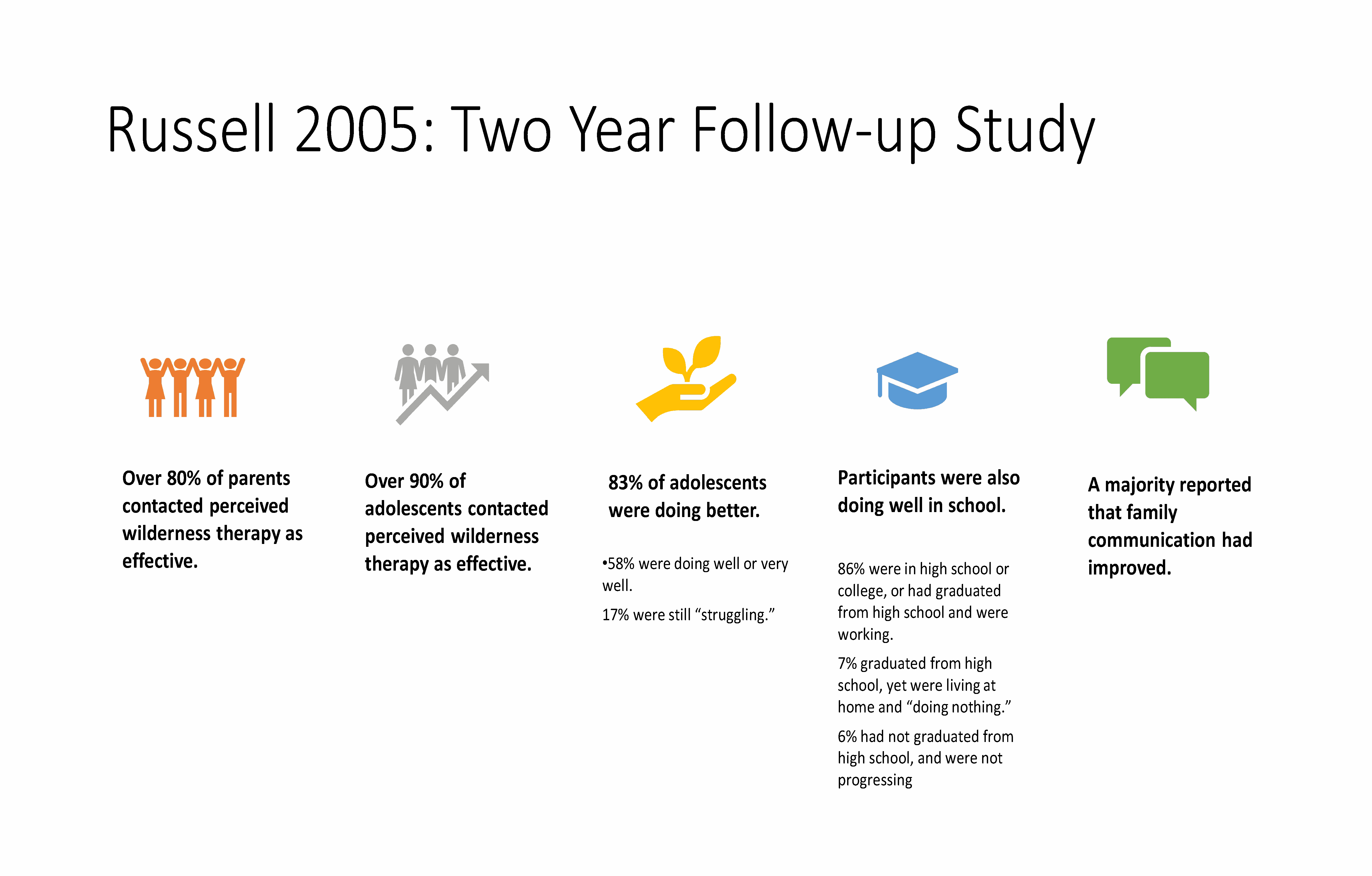
References:
In 2005, Dr. Russell published a two-year follow-up study.
Depression, Anxiety, and Stress-focused Study (Russell, 2006)
Rather than conducting a global study of adolescent functioning, this 2006 study looked at the interrelated issues of depression, anxiety, and stress.
Teens’ levels of depression, anxiety, and stress improved during the treatment process. Measurements for all three of these adverse factors improved significantly between the beginning and end of treatment.
Six months after treatment was completed, the teens had maintained the positive changes in their stress levels.
However, even more dramatically, the teens continued to experience reductions in both depression and anxiety even after treatment was completed.
Motivation Study (Russell, 2007)
One theory as to why wilderness therapy is successful is that it reengages people in the developmental process. In other words, the time spent in the wilderness motivates people to change.
When someone comes to wilderness therapy, they are taken away from distractions. They can engage in treatment in a way that would not be possible in any other setting.
According to the 2007 study:
- 44% of teens who entered wilderness therapy treatment were completely unengaged and unwilling to be involved in the treatment process.
- Almost a third of patients acknowledged that they needed help but were not willing to make any changes.
- One-quarter of the teens reported that they knew and acknowledged that they needed help. In other words, they were actively engaged in treatment.
By the time the teens were being discharged, there were some dramatic changes.
- 90% of the teens were actively engaged in treatment. They were no longer ignoring their problems.
- 9% of the teens were reluctant to be involved in treatment.
- 1% of teens were unwilling to engage in the treatment process.
When researchers followed up with teens six months after treatment, most teens maintained the motivational progress they made during treatment.
- 80% of the teens were fully involved in treatment.
- 20% were reluctant to be involved in treatment.
- 0% of the teens were unwilling to engage in the treatment process.
The study yielded weight to the theory that wilderness therapy treatment can help to reengage people in the developmental process.
The study yielded weight to the theory that wilderness therapy treatment can help to reengage people in the developmental process.
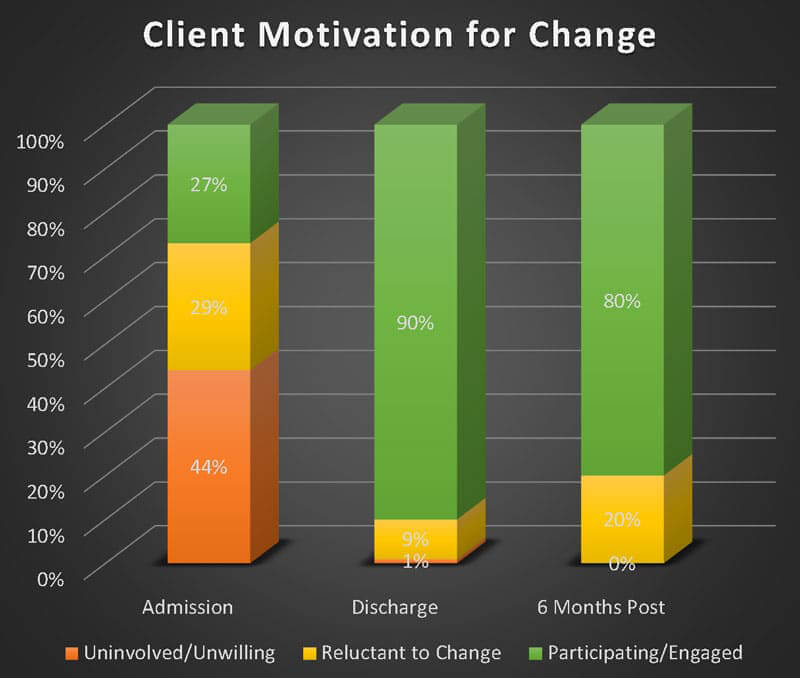
References:
Engaging Resistant Clients
Adventure Therapy (Magle-Haberek, 2012)
By 2012, adventure therapy was becoming increasingly popular. However, the Magle-Haberk study indicated that more time spent in adventure therapy did not improve treatment outcomes and even showed a small negative correlation with treatment outcomes.
In this form of adventure therapy, teens spend much of their time at a central location, leaving when they take part in adventure therapy.
As with previous studies, the more time teens spent in the wild, the more successful treatment was likely to be. That causes the Basecamp model form of adventure therapy to be less successful.
RedCliff Ascent used the information gained through this study and applied it to its own adventure therapy program as RedCliff Ascent added adventure therapy elements, but not to do so at the expense of treatment.
RedCliff Ascent uses adventure therapy in the context of the Continuous Flow Expedition model. For example, teens hike, mountain bike, and go fishing while they are in the backcountry.
They remain with their treatment groups during these adventure therapy activities. Therefore, they can enjoy these activities without disrupting the expedition or their treatment.
More time spent in adventure therapy did not improve treatment outcomes. As with previous studies, the more time teens spent in the wild, the more successful treatment was likely to be.
Safety Study (Outdoor Behavioral Council, 2013)
For some people, there is a perception that wilderness therapy treatment is dangerous. The Outdoor Behavioral Healthcare (OBH) Council conducted a ten-year study to examine the validity of that perception.
The council found that in 2012 the average American teen who is not engaged in wilderness therapy treatment is twice as likely to visit the emergency room as one who is.
The extensive and effective risk management techniques make wilderness therapy safer than various practices such as backpacking, downhill skiing, or playing high school football.
This does not consider many teens entering wilderness therapy treatment because they are engaging in high-risk activities at home.
OBH member programs such as RedCliff Ascent take part in stringent incident monitoring and reporting procedures. These practices help keep teens safe while maintaining treatment excellence.
Body Composition Study (DeMille 2014)
The benefits of wilderness therapy are not only mental and emotional—teens who participate in treatment also experience physical health benefits.
In this study, teens were grouped by Body Mass Index (BMI). They were categorized as underweight, healthy weight, overweight, and obese. The study was conducted with young men and women during both winter and summer sessions.
On average, teens participating in treatment moved toward healthier weight ranges. Underweight participants gained weight, predominantly composed of lean mass. Healthy-weight participants also gained lean body mass but stayed within the same weight range. Overweight and obese participants lost weight.
These changes in body mass remained consistent with both genders. The positive changes were present in both winter and summer sessions.
Mindfulness Study (Wilderness Therapy Symposium, 2016)
One of the many aspects that makes wilderness therapy treatment effective is that it can improve some aspects of mindfulness.
From the time teens enter wilderness therapy to when they leave, they can improve certain elements of mindfulness. These improvements are maintained after treatment is complete.
There are four specific elements of mindfulness that teens improve. First, they can better describe their own experiences. They can also act with awareness.
They can act in a nonjudgemental way. Moreover, the teens demonstrated a quality called nonreact. Nonreact means in difficult situations, teens were able to simply act rather than react.
They were able to observe their feelings without being lost in them.
References:
The Role of the Natural World and Mindfulness
Maturity Study (International Society for Research on Identity, 2016)
Teens who take part in wilderness therapy can reengage in the developmental process and make more age-appropriate decisions after they leave.
One of the reasons for this dramatic improvement could be that wilderness therapy helps teens with four distinct areas of psycho-social development.
Teens experienced improved hopefulness in their view of themselves and their relationships with others. This changing viewpoint led to more trusting and healthy relationships with others.
Teens also experienced decreased shame and doubt as a result of treatment. They were better able to make choices based upon their own will.
In a related finding, teens experienced reduced feelings of inferiority. Increased feelings of competency led to more stable perceptions of themselves.
Teens also experienced fewer feelings of confusion about their role in their lives. This brought the participants to age-appropriate levels of psycho-social development.
Gender Study (Journal of Psychology, 2016)
The gender of the participant is one factor that does not appear to influence the effectiveness of wilderness therapy treatment.
Based on parents' reports, young women entered treatment with higher levels of distress than young men. However, both genders equally benefited from treatment.
References:
An Exploration of Gender
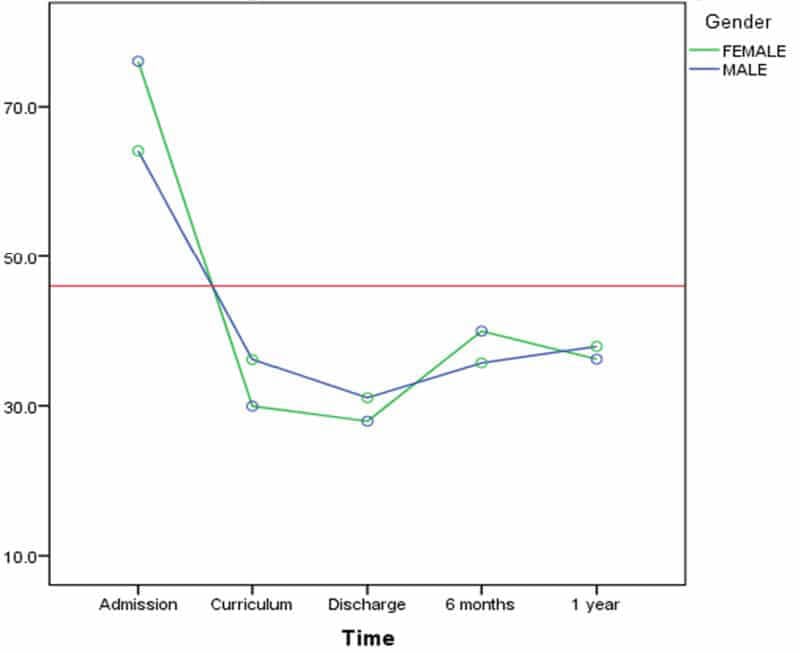
Control Group Study (DeMille, 2018)
In 2018, RedCliff Ascent conducted the first study, which compared its participants against that of a control group. Young people in the control group had similar levels of distress. They were treated with what was described as Treatment as Usual (TAU ).
TAU consisted of various forms of inpatient treatment, intensive outpatient treatment, and community support programs.
The study followed the RedCliff Ascent group and TAU group for fifteen months. Then, researchers followed up with both groups one year later.
Both groups made progress as a result of treatment. However, the gains made by the RedCliff Ascent group were nearly three times that of the TAU as measure by the Youth Outcome Questionnaire.
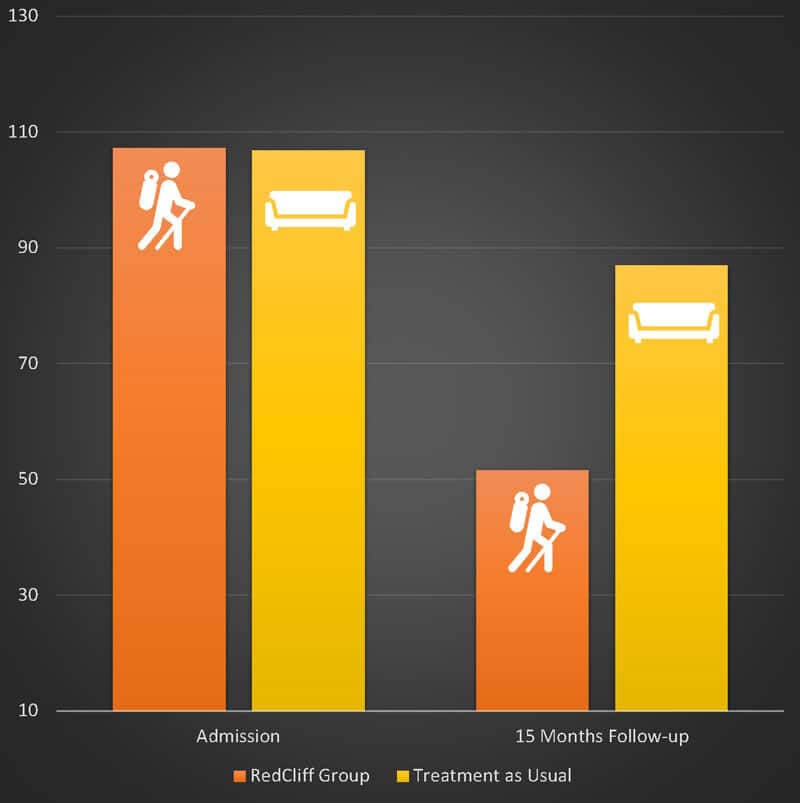
Cost-Benefit Analysis (Gass, 2019)
Teens who take part in wilderness therapy programs have a 94% completion rate. This compares to a 37% completion rate in other forms of treatment.
Also, wilderness therapy can help teens reach higher levels of healthy functioning faster. By achieving higher health levels in less time, participants experience increased quality of life across their lifetimes.
OBH has a cost-benefit ratio 60.4% higher than Treatment as Usual TAU
References:
The Value of Outdoor Behavioral Healthcare
Additional Reading
Wilderness Therapy More Effective and Less Expensive
Ongoing Wilderness Therapy Research (2021 and Beyond)
OBH is an ever-growing area of research. Organizations, such as the University of New Hampshire, continue to conduct research into OBH as a treatment for teens that have difficulties with emotional, behavioral, and relational disabilities. RedCliff Ascent remains an active participant at the forefront of OBH research.
Wilderness Therapy Research Summary
From its foundation in the 1990s, RedCliff Ascent considered developing evidence-based research so vital that it supported the creation of a comprehensive way to measure an adolescent’s healthy functioning. That metric became known as the Youth-Outcome Questionnaire or Y-OQ. RedCliff Ascent uses information from the Y-OQ to refine its practices in real-time.
Multiple researchers across many years have demonstrated that teens enter wilderness therapy treatment with higher levels of dysfunction than when they leave. Moreover, teens who complete wilderness therapy treatment maintain positive changes in a broad range of functioning long after treatment has been completed.
More than a decade of research indicates that wilderness therapy treatment is not only safe; it improves teens’ mental and physical well-being.
By continuously conducting research, RedCliff Ascent can make program decisions that result in the best outcomes for the young people in its care. For example, the early analysis indicated that more time spent in the wilderness produced more positive changes in teens’ outlook and behavior.
- The program has also avoided fad forms of treatment, such as 30-day stays because the research provided clear evidence that more extended stays were more beneficial.
- Evidence-based processes also help to guide the incorporation of new forms of treatment, like adventure therapy, in such a way that provides the greatest benefit.
- Research indicates that teens who complete wilderness programs can expect to experience reductions in depression, anxiety, and stress. Moreover, depression and anxiety will likely continue to decrease after the completion of treatment.
- There are likely multiple factors that cause wilderness therapy treatment programs to result in these treatment gains. Some of these factors are physical; for example, improvements to teens’ physical well-being in the form of closer attainment of a healthy body mass.
- Other factors are mental and emotional, such as reengaging teens in a healthy developmental process by putting teens in an entirely novel environment and disrupting negative behavioral patterns.
- Wilderness therapy treatment programs also promote some aspects of mindfulness, such as helping teens to describe their own experiences, act with awareness, and respond to challenging situations in nonjudgemental ways.
- The treatment process also helps teens to reach age-appropriate levels of maturity.
- These benefits have been demonstrated in multiple studies. They are seen in participants of both genders.
- When compared against young people at similar levels of distress who receive treatment in other settings, wilderness therapy participants are more likely to complete treatment. Participants in wilderness therapy showed nearly three times the gains compared to teens who received other forms of treatment.
- By helping teens achieve higher levels of healthy functioning in less time than other forms of treatment, wilderness therapy programs dramatically improve their quality of life.
RedCliff Ascent has achieved what it set out to do 30 years ago, with treatments that are scientifically researched and backed up.
In many ways, the decision to enroll in RedCliff Ascent comes down to this: the desire to see a real change come over your teen. But it’s not just for your teen, RedCliff Ascent works to reestablish family unity by bridging the gap between unhealthy behaviors and tendencies, and measurable growth and improvement. We are the gateway to improved development. RedCliff Ascent has done exactly what it set out to do 30 years ago. Our treatments are researched and backed. Participants saw quantitative success; our mission is reflected in the eyes of those we have helped. Check out our testimonials to see the amazing things we can do. RedCliff Ascent can and will do everything in our power to improve the life of your teen and your family.
Our treatments are researched and backed.





